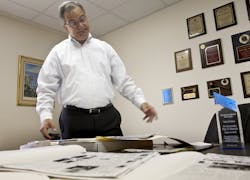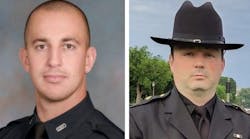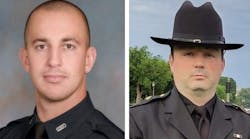One day in December, Miami-Dade police detectives drove to a gated community in Southwest Ranches to knock on the door of a 64-year-old woman, hoping her adolescent memories would bring answers to a decades-old question:
What happened to Danny Goldman?
There was a time when that was the biggest mystery in South Florida.
In the early-morning hours of March 28, 1966, a portly, graying gunman broke into the Surfside house that 17-year-old Danny Goldman shared with his mother and father. The gunman bound Danny's parents and demanded $10,000 cash; when no money was found, the attacker left with Danny, threatening to kill the teen if the Goldmans didn't come up with $25,000 by that evening.
"Do what the man says," Danny's father, Aaron Goldman, instructed as the kidnapper took the teen away. They were the last words Goldman said to his son.
The kidnapper never called for the ransom, and Danny Goldman was never seen again. The strange abduction, once the stuff of national headlines, eventually faded from local memory. The crime, which occurred 47 years ago this past Thursday, remains unsolved today.
Now a group of volunteers -- friends and alums of Miami Beach Senior High, where Danny went to school -- are trying to bring new attention to the once-famous kidnapping. Leading the cause is attorney Paul Novack, the former mayor of Surfside.
"It was always a community mystery, from when I was little," said Novack, who lives near the Goldman house. "We just thought the whole memory of Danny's existence shouldn't be buried with his parents" -- both of whom died in the past three years.
For the past 12 months, Novack has immersed himself in the case, collecting old police reports and yellowed newspaper clippings, interviewing retired detectives and aging Goldman family friends, hoping, just maybe, to solve the mystery of Danny Goldman's disappearance -- though most of those familiar with the case have since died.
Was the kidnapping just a case of mistaken identity, as Danny's father speculated in 1966? Or perhaps the Goldman family was targeted for retaliation: At the time of the kidnapping, Aaron Goldman was aiding the FBI in a fraud investigation at a local bank, where he had been a board member.
Novack believes the real story is even more fantastic: an Oliver Stone-meets-James Ellroy tale involving a notorious burglar with ties to both the Mafia and a gang of corrupt cops -- the very cops in charge of investigating the Danny Goldman kidnapping.
While Novack's theory may seem far-fetched, the cold-case unit at the Miami-Dade Police Department thought there was enough to it to reopen the long-dormant case last year.
Which led detectives to Southwest Ranches, to the home of 64-year-old Sharon Ramos, formerly Sharon Lloyd, once the teenage girlfriend of Danny Goldman.
Ramos was a fixture at the Goldman house in the weeks following Danny's abduction. In the years after the kidnapping, witnesses told police that Ramos might know more about the crime than she originally let on.
Several threads lead from the dusty Goldman files back to Ramos' father, to her first husband, and to Ramos herself. But of the many questions the cold-case detectives had for Ramos, the most intriguing may have been this:
What did she know about a man named Chicken?
Mysterious money stash: the Vietnam War theory
The police bulletin described the kidnapper this way: "White male, in his fifties, 5 feet 8 inches, 180-200 pounds, stocky build, wearing glasses with silver rims." He wore dark clothes and a baseball cap as he entered the house at 1101 88th St. through an unlocked patio door in the pre-dawn dark.
The intruder bound Aaron Goldman and his wife, Sally, and gagged them with tape -- but he checked that Sally's bindings weren't too tight, and made sure she could breathe. Danny also was tied up. The intruder seemed to know about his victims, calling Danny's parents by their first names.
"He didn't ransack the house like a burglar would do," Aaron Goldman told a reporter a few months after the kidnapping. "He showed a feeling of gentleness."
He also showed purpose: He was expecting to find $10,000 in cash. "Don't be frightened or scream. You know what I am here for," the intruder said, according to police records.
Goldman told the heavyset man that there was no money in the house, but he offered to write him a check.
Why would the intruder think there was cash in the house? Novack has a theory: Danny's mother feared that Danny, turning 18 the next day, would get drafted to fight in the Vietnam War. Novack believes the Goldmans may have socked away cash to set their son up outside the country -- or at least that's what the burglar believed.
But when he found no money, the intruder took Danny away at gunpoint, telling his parents to have $25,000 ready by that evening. They drove off in Danny's car, which was found hours later several blocks away on Harding Avenue.
The days and weeks that followed became a surreal vigil. Detectives with the Dade County Sheriff's Office (now the Miami-Dade Police Department) and the FBI camped in the Goldmans' front yard daily, along with radio, television and newspaper reporters, waiting for any word from the kidnapper.
Also on the scene: 17-year-old Sharon Lloyd, who shared photos of Danny with reporters and brought bologna sandwiches for the cops.
Danny's parents appeared on television to make a public plea to the kidnapper, offering the $25,000 ransom, no questions asked. "Just get the word to us, and we will do anything you and your representative directs," they said in an "open letter" to the kidnapper. "You may contact us through the mail, through a clergyman, through an attorney or by direct telephone contact -- but please let us hear from you immediately."
The phone instead became a torment. It would ring 20, 25 times a day -- but never the kidnapper. Often there were crank callers; other times, creepy silence. Con artists from Boca Raton and St. Petersburg masquerading as the kidnapper set up meetings to pick up the ransom; both were arrested.
By May 1966, the FBI had packed up its command post at the Goldman house. The Goldmans even offered a "minor reward" for the return of their son's body -- too high a price, they worried, would give the kidnapper a reason to kill Danny if he was still alive.
There was no shortage of suspects, or theories. Aaron Goldman later said that Dade County sheriff's detectives first believed Danny had run away, and the abduction was a ruse. But the FBI treated the case as a serious kidnapping from the start, chasing tips and leads from Florida to Texas.
"The main theory in the case was that the kidnapper was someone who had a bad business experience with Danny's father," said Clarence Jones, a former investigative reporter who covered the Goldman case for The Miami Herald. "There were [FBI] agents who worked 16 hours a day with no days off for months."
For a time, investigators focused on Goldman's role at a Miami Beach bank that was under investigation at the time by both the FBI and bank regulators. Goldman, a shareholder of the Five Points National Bank, complained about the conduct of the bank's new directors, and he was interviewed by the FBI about the bank before the kidnapping.
Three months after Danny's abduction, 19 bank directors and officers were indicted on federal fraud charges; Goldman was not among them. Investigators, however, could find no connection between the bank probe and the abduction.
The kidnapping investigation then seemed to cool -- until October 1968, when a detective traveled to Raiford, Fla., to meet a prison inmate named Robert Byron Landry.
Landry -- who was convicted years later of a notorious 1981 murder-for-hire in Colorado -- said he heard talk about Danny Goldman's disappearance while hanging around with Sharon Lloyd, her father, Charles Lloyd, and a thief named John Newsom, records show. In Landry's telling, Danny was killed, and his body then dumped in the Gulf Stream by Wally Jefferson, a former Miami cop and bail bondsman who owned a boat.
Jefferson was indeed close with Sharon and her father. In June 1968, the three of them were arrested together outside the Miami-Dade courthouse; Sharon was accused of trying to run down a deputy who was trying to arrest Jefferson on an outstanding warrant. (The charges against Sharon were later dropped.)
It wasn't until 1972, some four years later, that detectives interviewed Newsom, records show. Echoing Landry's story, Newsom said Lloyd's father told him that Danny had been killed and dumped at sea.
By the time detectives interviewed Newsom, both Charles Lloyd and Jefferson had died. Sharon, who was 23 years younger than Jefferson, was listed as Jefferson's wife on his 1970 death certificate.
Newsom, who died in 1974, also mentioned another potential suspect, a man he says he met at the apartment Sharon shared with her father: a burglar and fringe gangster named Joseph Cacciatore, also known as "Chicken."
The famed mobster's ne'er-do-well cousin
The Miami Beach of 1966 was a sun-bleached pastiche of the jet-set and the low-rent. Bejeweled New Yorkers descended in wintertime to populate the swooping hotels along Collins Avenue. Meanwhile, the stucco ranchettes of beach towns like Surfside and North Bay Village gained favor among those "connected" to the northern crime syndicates -- mobsters drawn to South Florida by the sun, and the proximity to Havana, a gambling hub until Fidel Castro closed the last of the casinos in 1961.
Cacciatore lived on the edge of both of these worlds. He was a cousin of Santo Trafficante, the Tampa-born Mafia boss said to have controlled many of Havana's casinos during the Batista era. Like Trafficante, Cacciatore frequently shuttled between Tampa and Miami -- though Cacciatore's crimes were not nearly as ambitious.
Cacciatore's specialty was burglary -- specifically, hotel burglaries from Miami Beach to Hollywood. He was known for targeting beachfront hotels, looking for jewels and furs of well-heeled guests. Once he was found with a key ring containing 43 different keys, including keys to some hotels; another time, he was pulled over with $200,000 in stolen jewels in his car.
By 1966, his record included at least 10 arrests for burglary, robbery and possession of bolita gambling sheets -- from the illegal numbers game that was popular in Miami at the time. (In one case, Cacciatore's alibi witness was Frank Sturgis, who was later convicted as one of the Watergate burglars.) Just a month before the Goldman kidnapping, Cacciatore was arrested for breaking into a 14th-floor room at the Fontainebleau Hotel in Miami Beach.
Cacciatore was 5-foot-7 and 175 pounds, with "black-gray" hair, prison records show. At the time of the Goldman kidnapping, he was 50 years old, and he was free on bail while appealing a burglary conviction. Despite his lengthy record and his physical similarities to the kidnapper -- right down to the eyeglasses -- Cacciatore was never seriously considered a suspect in the abduction at the time.
"He was certainly known to the police," Novack said. "There's nothing I've seen that would indicate he was ever questioned."
Novack believes he knows why: Among Cacciatore's partners in crime were several Dade County sheriff's deputies -- including some of the detectives overseeing the Goldman investigation.
When crooks and cops were hard to tell apart
Corruption was a persistent problem at the sheriff's office at the time of the Goldman kidnapping. A 1966 grand jury report described the department's see-no-evil approach to gambling and prostitution at a time when organized crime was at its height.
"During the past 10 or 15 years, gambling, prostitution and other forms of vice have flourished in Dade County with the obvious knowledge and active cooperation or tacit acquiescence of many local law enforcement agencies," the grand jury found.
The corruption seeped into the highest ranks of the department to the sheriff himself, the grand jury concluded. In October 1966 -- seven months after the Goldman kidnapping -- five sheriff's deputies were indicted on burglary or larceny charges, including Lt. Leslie Van Buskirk, chief of the police division; Maj. Manson Hill, chief of the detective bureau, and Sgt. David Helman, head of the sheriff's intelligence division. Around the same time, Dade County Sheriff Talmadge A. Buchanan was named in two separate indictments for perjury and bribery conspiracy.
Helman faced a separate indictment for allegedly helping another burglar who was breaking into rooms at the Dunes Motel on Collins Avenue in February 1965. The burglar: Joseph "Chicken" Cacciatore.
The indictments against the sheriff and his staffers were all dismissed, largely due to a 1967 U.S. Supreme Court ruling that said the law officers' compelled testimony to the grand jury was improper. But the taint of scandal remained: Hill, who resigned a month before the indictments, never returned to the force. Helman became a bail bondsman and private investigator; in 1970, when called to testify in the corruption trial of another disgraced Dade deputy, he refused, pleading the Fifth Amendment 49 times.
Both Helman and Hill played key roles in the Goldman kidnapping investigation while with the sheriff's office. Helman stood watch over the Goldman home on the first night after the kidnapping; Hill, who supervised the investigation, was on guard on the second night.
If Cacciatore was involved in the kidnapping, Helman would have had reason to steer the investigation in another direction, out of fear that his ties to Cacciatore could be exposed, Novack says. But Novack's theory raises more questions: If Cacciatore was the kidnapper, why didn't Danny's parents identify him in late 1966 or 1967, when Cacciatore's name, and face, became front-page news in the sheriff's office corruption scandal?
Any conspiracy of silence died long ago along with the players: Helman, Hill and Cacciatore are all dead.
A woman orders a drink in a bar....
The investigation fell dormant again for several years, but for one additional clue: In 1986, an unidentified woman drinking in a Miami bar began offering details about the case. She said she had been Danny's girlfriend, and that Danny had been killed because he recognized one of his captors, and then dumped at sea. She implicated a bail bondsman in the crime -- an apparent reference to Wally Jefferson. A bartender later called the Surfside police, but the woman, gone by then, was never identified.
The police report of the bartender's story was then lost, though Surfside police recreated the report when they reopened the Goldman investigation along with the Florida Department of Law Enforcement in 2000. But the 2000 investigation did not find any new information.
Novack hopes the cold-case detectives now working the case will find more answers. Last year, Miami-Dade police released a time-lapse image of what a 64-year-old Danny Goldman might look like today -- in case Danny is actually alive somewhere. Police also collected a DNA sample from Danny's 95-year-old aunt just days before she died, so investigators have a sample for comparison in case a body is later found.
Novack and his partners have also created a website, www.surfsidekidnapping.org, that includes photographs, old TV footage and newspaper clippings, hoping to spark more interest in the case.
Miami-Dade police declined to provide specifics on the state of the investigation today. But detectives have talked to Danny's former girlfriend, Sharon Ramos.
Earlier this month, in a brief interview with The Miami Herald, Ramos said she has been in contact with a Miami-Dade police sergeant. Ramos said she had no new information about the case, and said she was not the mysterious woman who described Danny's death to a bartender in 1986.
"I knew that the case was reopened," said Ramos, who said medical problems prevented her from sitting down to a lengthier interview with reporters. "I don't know anything."
Novack realizes that the chances that police will solve the Goldman kidnapping 47 years later are, at best, remote. But he hopes the new investigation can turn up enough new information that could point to "some solution to the mystery."
But Jones, the former Herald reporter, suspects the Goldman kidnapping is a mystery that will remain unsolved.
"If they couldn't solve it then, I don't think it's possible to solve it now."
Copyright 2013 - The Miami Herald
McClatchy-Tribune News Service



